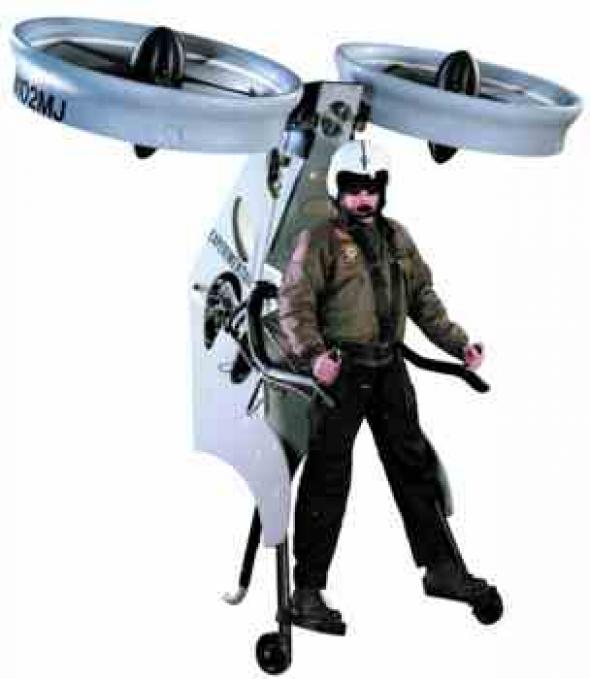Pack to the Future
Jetpacks promise so much, but they have yet to deliver the dream of solo flight. Marina Vishmidt ponders why tomorrow sometimes never comes
In The Arcades Project, Walter Benjamin wrote: ‘In nature, the new is mythic, because its potential is not yet realised; in consciousness, the old is mythic, because its desires were never fulfiled.’ The image of individual flight beckons in all its symbolic plenitude our attempts to transcend nature by emulating it. From the hubris of Icarus to da Vinci’s experiments with bat wing prototypes, the image persists into the narrative of modernity. The aeroplane was the military-industrial sublimation of an evolutionary nostalgia to fly like the birds. The invention of mass individuality occurred just in time for the invention of mass flight, but propulsion into super-modernity could only come from the jetpack. And what could be a more congenial environment for dismantling limits on personal freedom than mid-century America? The convergence of the technologies of marketing, scientific innovation and fantasy accelerated during the Cold War. The world of tomorrow was never nearer than in the spectacular formations of fully automated houses and the space programme. Now dismissed as future kitsch, the technological imaginary of the era never fully revealed its implications. Much of it was so out there that it became a form of instant kiddie merchandise. Few things, however, were more instantaneously awesome than Buzz Lightyear lifting off at the 1950’s World’s Fair or demonstrations of jetpacks at the 1984 Olympics in LA.
The jetpack addressed the needs of the Organisation Man to get away from it all: from the tedious manifestations of bureaucratic collectivity, and from open plan offices and traffic jams. Rugged individual flight affirmed the irreducibility of the pioneer spirit over the depredations of the Great Society. The liberation theology of the jetpack still functions on this predictably atomising level. We see ads for jetpacks on the internet that work with a Gnostic enthusiasm: ‘things are so beyond repair down here, let’s just fly away’, ‘But there is hope – engineers are attempting to give us back true mobility by developing personal jetpacks that will eliminate the need for roads altogether!’ Let the future come so we can stay in the present: an ideology familiar from the example of the internet itself. But also like the internet, the jetpack doesn’t reduce to just a dumb reification of an ancient dream of transcendence. The internet is contested by tendencies that wish to produce the individual as a consumer in a delivery system and those that seek autonomous agents in a network. What new subjectivities can the jetpack bring about? The jetpack eliminates obstacles to mobility, freeing us up to think about where we are going – a technology to free us from technology. Infrastructure such as roads and airports – are they not relics of an unthought industrial eternal present we might do well to forsake, especially those of us who are always late? Jetpacks harbour a plethora of the most shamelessly utopian visions: freedom from fossil fuels and freedom from borders, the flow of persons as untrammelled as the flow of data. Conversely, the jetpack can be figured as the greatest semiotic shorthand for globalisation yet – capital bestriding time and space.
But like any technology overcoded with fantasy and disutility, jetpack R&D has been stuck recapitulating the same square one since the 1960s. A recent test by Millennium Jet, a Silicon Valley firm, achieved results ‘that lifted the company’s CEO to a height of two feet, for twenty seconds.’ Compare this to the 1960s when ‘Wendell Moore, an engineer at Bell Aerospace, designed the Bell Rocket belt. Partially funded by the US military, this was a small back-mounted pack that could thrust a person into the air for what amounted to a twenty-second hop.’ So, when do we start watching the skies?
Marina Vishmidt <marina AT vishmidt.freeserve.co.uk> is a film/video maker and writer and she enjoys cycling between South and East London.
Mute Books Orders
For Mute Books distribution contact Anagram Books
contact@anagrambooks.com
For online purchases visit anagrambooks.com








